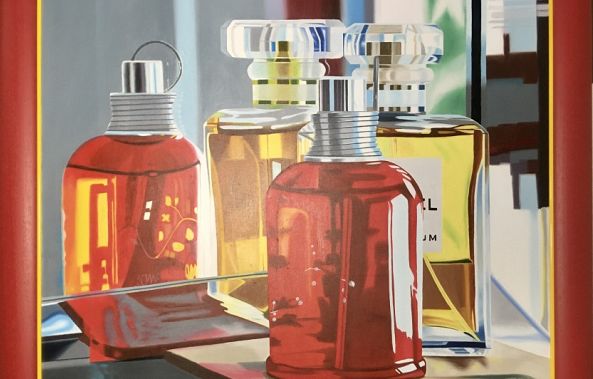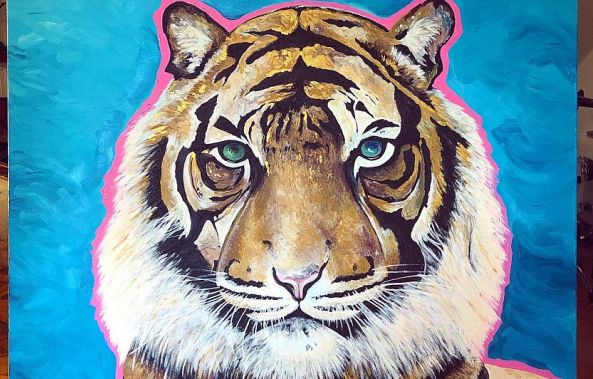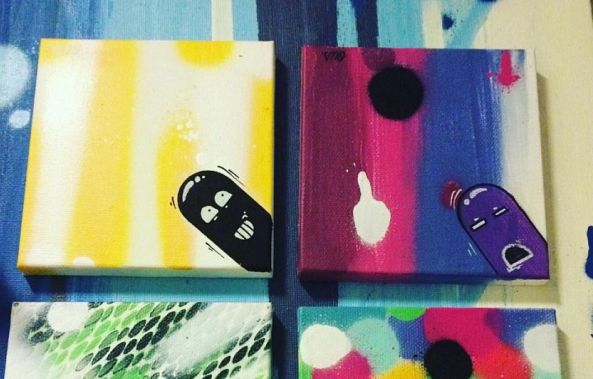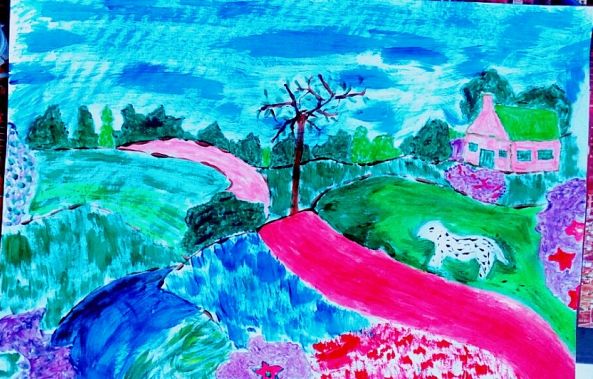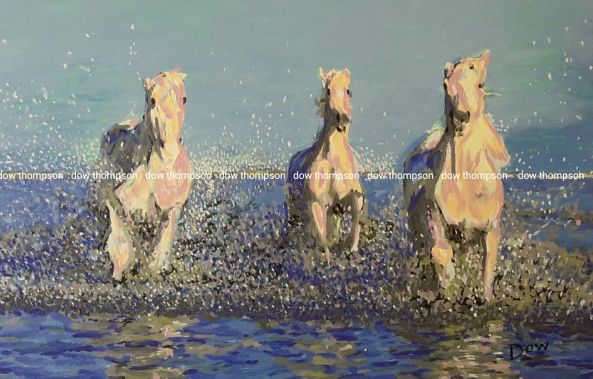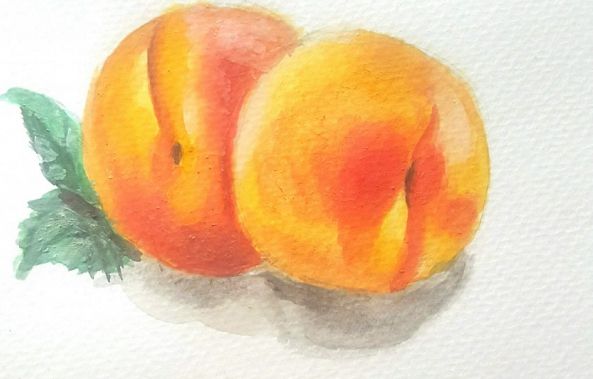Michelangelo: biography, facts; famous paintings
Who Was Michelangelo?
Michelangelo Di Lodovico Buonarroti Simoni was born on March 6, 1475 in Caprese Republic of Florence, Italy, as the second of five sons. He passed on 18th February 1564 in one of the state of Rome. He was an Italian Renaissance sculptor, printer, architect and poet who brought about second-to-none impactful development of the Western art. This Italian artist was considered one of the greatest expressionists of his time, and he has ever since been held in high esteem when it comes to the creation of art. Many of his paintings, sculptures and architectures have ranked among the famous there are in the world. The frescoes on the ceiling of the Sistine Chapel in the Vatican are perhaps the best of his works known today, Michelangelo yet thought of himself fundamentally as a sculptor. His affiliation and practice with several fields of arts were somewhat unusual in his time, however, because it was an era of design and drawing. He worked on marble sculptures virtually all his life, and minored in other arts during other times. The high reverence for Sistine is partly a reflection of the greater attention he paid to painting later in the 20th century, and, partly too, because many of his works in other media remained incomplete.
One of the many rub-offs of Michelangelo’s lifetime fame is evident in his career being more fully documented than that of any other artist during his time and earlier. He happened to be the first artist from the West whose biography was published while he was yet alive. As a matter of fact, there were two rival life accounts documented. The first was the last chapter in the series of artists’ lives (1550) by Giorgio Vasari, a painter and architect. This was the only chapter about a living artist which explicitly showcased the works of Michelangelo as he resulting masterpieces of art that far offset the efforts of those before him. In spite of such a eulogy, he wasn’t completely pleased and ready for Acanio Condivi, his assistant to write a briefer different book in 1553, perhaps due to the artist’s own spoken comment which made the account show him the way he wished to appear.
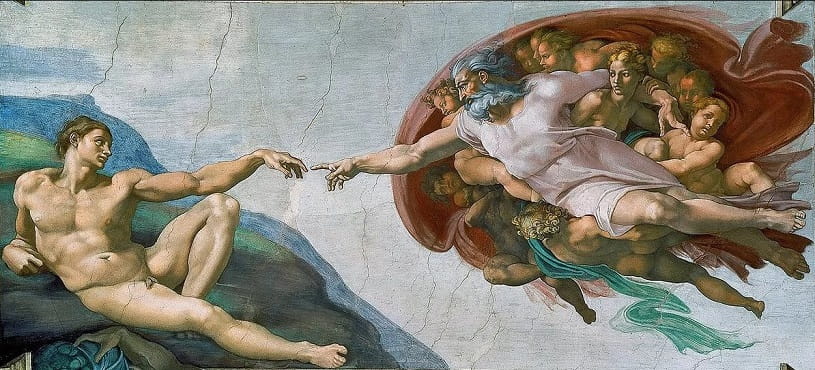
The Creation of Adam Image via http://www.oeuvres-art.com
After his death, Vasari wrote in a second edition in 1568 offering a rebuttal. While scholars have most times opted the authority of Condivi, Vasari’s lively writing, coupled with the importance of his book as a whole and the frequent reprinting languages, have contributed to making it the most usual basis of widespread ideas on Michelangelo and other renaissance artists. Michelangelo’s fame also resulted in the preservation of numberless momentos, including hundreds of letters, sketches and poems – yet more than any other contemporary. Still, regardless of the enormous benefits that has been accrued from all this, during controversial topics, only Michelangelo’s side of the argument is often known.
During the time of Michelangelo’s’ birth, his father Leonardo Simoni was serving for a short time as magistrate in Caprese. The family returned to Florence during Michelangelo’s infancy. His mother, Francesca Neri, was ill, so the baby was put in the care of a family of stonecutters, a place Michelangelo later jested with the expression, “With my wet-nurse’s milk, I sucked in the hammer and chisels for my statues”.

The Statue of David Image via https://www.ccbs.edu
Michelangelo indeed didn’t have much interest in schooling. According to his earliest biographers Vasari, Condivi and Varchi, he preferred watching painter at the nearby churches draw. It could have been his friend from grammar school, Francesco Granacci who was six years his senior, that introduced him to a painter named Domenico Ghirlandaio. Michelangelo’s father came to realize earlier on that his son didn’t take any interest in the financial business of the family. This was what led to the decision to apprentice him at the age of 13 to the fashionable Florentine painter’s workshop. That was where the major exposure to the technique of fresco formed for Michelangelo.
Michelangelo and the Medicis
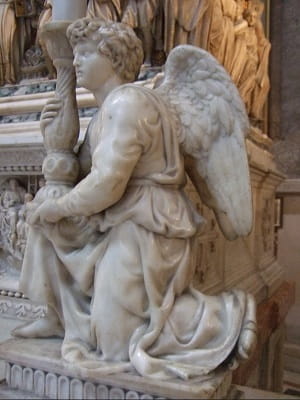 |
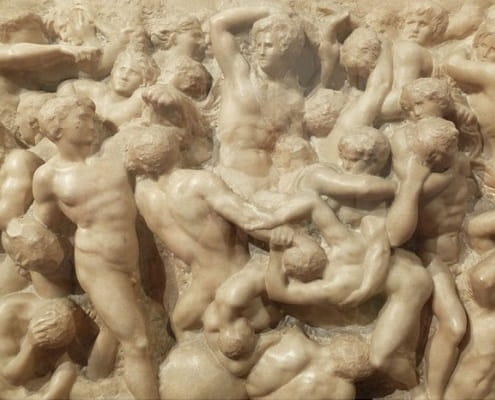 |
| Angel by Michelangelo Image via wikimedia.org | Battle of the Centaurs Image via http://www.arttrav.com/ |
Michelangelo learned the art of classical sculpture in the palace gardens of Florentine ruler Lorenzo the Magnificent from the influential Medici dynasty. He studies this from 1489 through to 1492. The big opportunity came about for him after a year’s time at Ghirlandaio’s workshop, in line with the recommendation of his mentor. This proved a very productive time for him. His years with the Medici family gave him the avenue to access the Florentine social elite, which in turn allowed him to study under the tutelage of a renowned sculptor – Bertoldo Di Giovanni. He was exposed to prominent poets, scholars and humanists whose ideas formed his versed experience. As well he obtained a special permission from the Catholic Church to study cadavers to garner insight in anatomy, even though the exposure to corpses had an adverse effect on his health.
All these collectively contributed to laying the foundation of what was to become the distinctive style of Michelangelo – a muscular precision and reality compounded with a nearly lyrical beauty. Two relief sculptures that survive, "Battle of the Centaurs" and "Madonna Seated on a Step," are testaments to his unique talent at the tender age of 16.
Moving to Rome
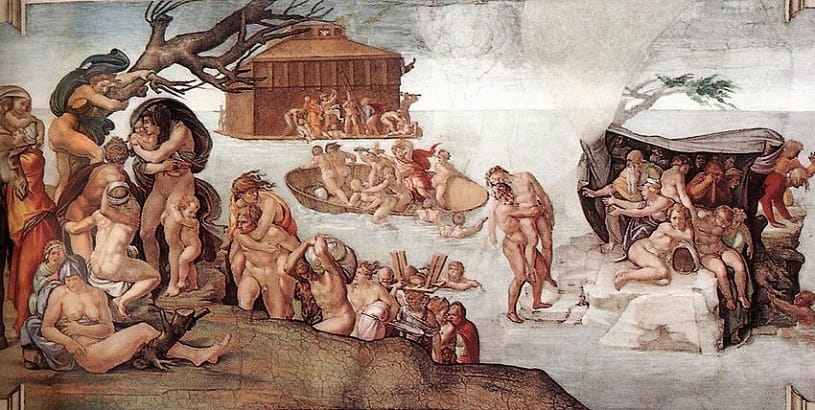
?The Deluge Image via https://www.michelangelo.org/
Michelangelo fled to Bologna to continue his study because of the political strife that followed the death of Lorenzo the Magnificent. He returned to Florence in 1495 and began to wokt work as a sculptor, along which he modelled his style after masterpieces of classical antiquity.
There are several versions of an intriguing story about Michelangelo's "Cupid" sculpture, which was artificially "aged" to resemble a rare antique: One version claims that Michelangelo aged the statue to achieve a certain patina, and another version claims that his art dealer buried the sculpture (an "aging" method) before attempting to pass it off as an antique.
Discovering that he’s be defrauded, Cardinal Riario of San Giorgio demanded a refund after he bought the cupid sculpture. Rather bizarrely, he was so impressed with the handiwork of Michelangelo that he let the artist keep the money. This Cardinal even invited Michelangelo to Rome, where he would live and work for the rest of his life.
On February 18 1564 weeks before his 89th birthday, Michelangelo breathed his last. He died at his home in Macel De'Corvi, Rome after a brief illness. His nephew took his remains back to Florence where he was respected by the public and revered as the father and master of all arts. At the Basilica Di Santa Croce, his preferred burial ground, Michelangelo was finally laid to rest.
Personal Life
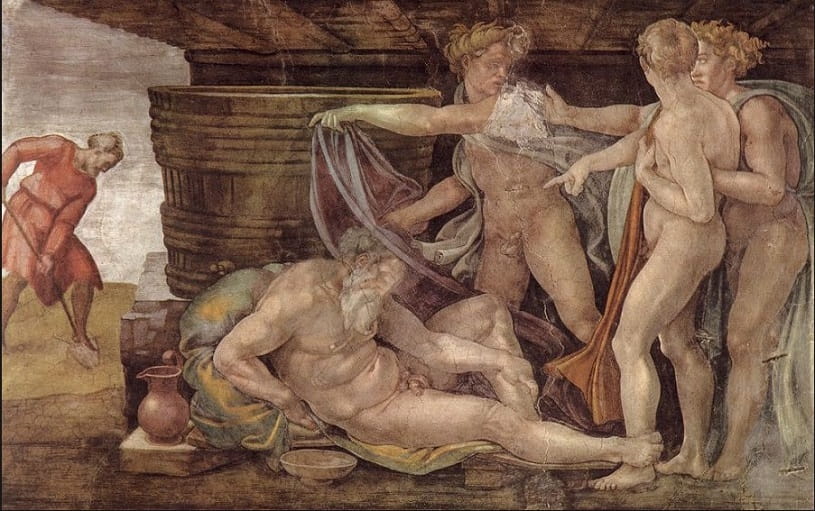
The Drunkenness of Noah Image via https://www.michelangelo.org
Michelangelo was a pious Catholic whose faith grew stronger close to the end of his life. Living an abstemious life, he told his apprentice Ascanio Condivi, “However rich I may have been, I have always lived like a poor man”. This particular apprentice said his master was indifferent towards food and drink. Michelangelo ate more out of necessity than of pleasure, and often slept in his clothes and boots. Paolo Giovio, one of his biographers, says that “Michelangelo’s nature was so rough and uncouth that his domestic habits were incredibly squalid, and deprived prosperity of any pupils who might have followed him”. He may not have minded, since he was by nature a solitary and melancholy person.
It remains somewhat impossible for one to certainly know whether he’s had physical relationships with women, perhaps owing to the fact that Condivi described him in that regard as a monk-like chastity. The attire of his sexuality is made apparent in his poetic works. Michelangelo wrote more than three hundred sonnets and madrigals.
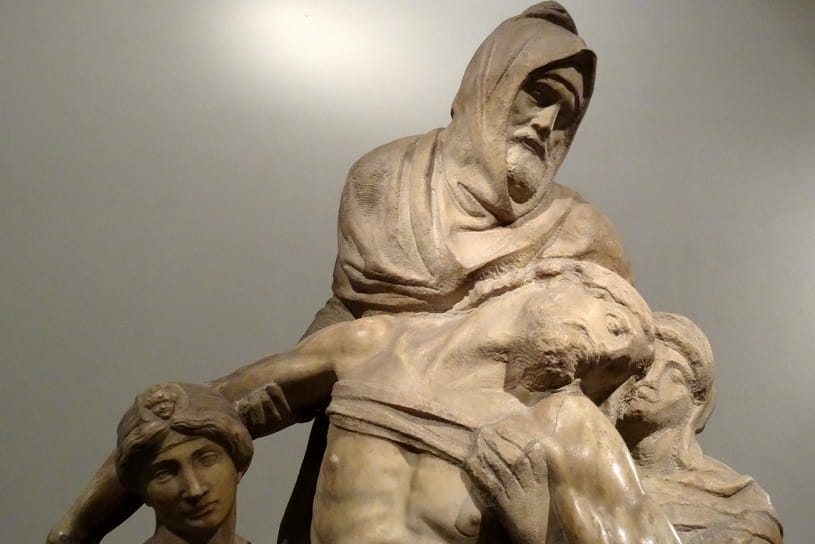
Self-portrait of Michelangelo as Nicodemus Image via https://www.youtube.com/watch?v=xl4OJu2UrqA
The longest sequence displaying a great romantic friendship, was written to Tommaso Dei Cavalieri (c. 1509–1587), who was 23 years old when Michelangelo met him in 1532, at the age of 57. These make up the first large sequence of poems in any modern tongue addressed by one man to another; they predate by fifty years Shakespeare's sonnets to the fair youth.
Cavalieri replied: "I swear to return your love. Never have I loved a man more than I love you, never have I wished for a friendship more than I wish for yours." Cavalieri remained devoted to Michelangelo until his death Michelangelo met Cecchino Dei Bracci in 1542, but the friend died a year later. His death inspired Michelangelo to write forty-eight funeral epigrams. Some of the objects of Michelangelo's affections, and subjects of his poetry, got the better of him - the model Febo Di Poggio asked for money in response to a love-poem, and a second model, Gherardo Perini, stole them from him shamelessly.
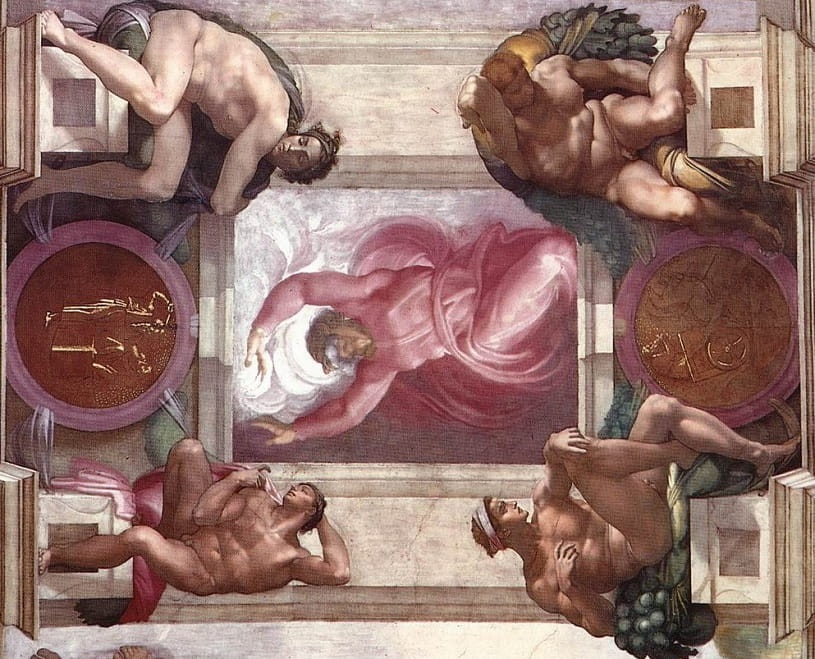
The First day of Creation Michelangelo Image via http://arthistoryblogger.blogspot.com
Later generations have experienced discomfort sources from the openly homoerotic nature of his poetry. His grandnephew, Michelangelo Buonarroti the Younger, published the poems in 1632 with the gender of pronouns changed, and it wasn’t until John Addington Symonds rendered them in English in 1893 did the original genders get restored. Even in modern times some scholars continue to insist that, despite the restoration of the pronouns, they represent "an emotionless and elegant re-imagining of Platonic dialogue, whereby erotic poetry was seen as an expression of refined sensibilities".
Vittoria Colonna, a lady who was then in her late forties. It was later in his life that he nurtured platonic, organic love for this female poet and noble widow who he met in Rome in 1536 or 1538. The duo wrote sonnets for each other, and they remained in contact until her death. The sonnets mostly centered their preoccupying spiritual issues. Condivi recalls Michelangelo's saying that his sole regret in life was that he did not kiss the widow's face in the same manner that he had her hand.
The List of Most Famous Sculptures and Paintings
1. Nine scenes from the Book of Genesis at the Sistine Chapel (1508-1512)
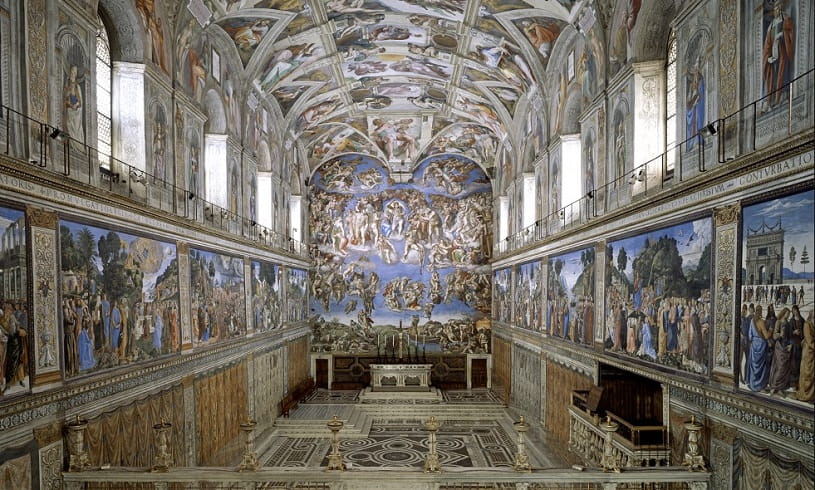
Image via http://www.museivaticani.va/
According to the vision of the unruly Pope, Julius II, Michelangelo was given the responsibility of creating a series of frescoes that would conceal the entire ceiling of the Sistine Chapel. He painted the frescoes with his feet on special scaffolding while positioned in an inconvenient position where his head was in an upward position every time.
2. The Last Judgment (1536-1541)
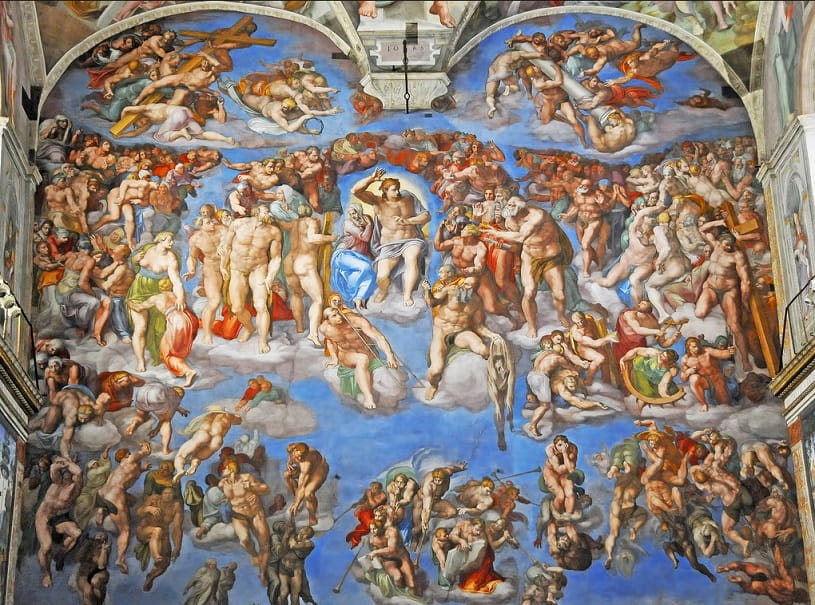
Image via https://www.flickr.com
After twenty-five years of completing the painting of the scenes from the book of Genesis, Michelangelo began work on The Last Judgment project. The Last Judgment is situated within the Sistine Chapel in the front altar segment. He was picked by Pope Clement VII to create the painting. The idea was changed as the original design was Resurrection after the death of Clement VII and Pope Paul III was used as his replacement. The new Pope preferred the Last Judgment as it was considered to be suitable for the 1530s Italy. Michelangelo, in his works always make a concerted effort at breaking with the ethics of portraying religious scenes.
3. The Crucifixion of St. Peter (c. 1546–1550)
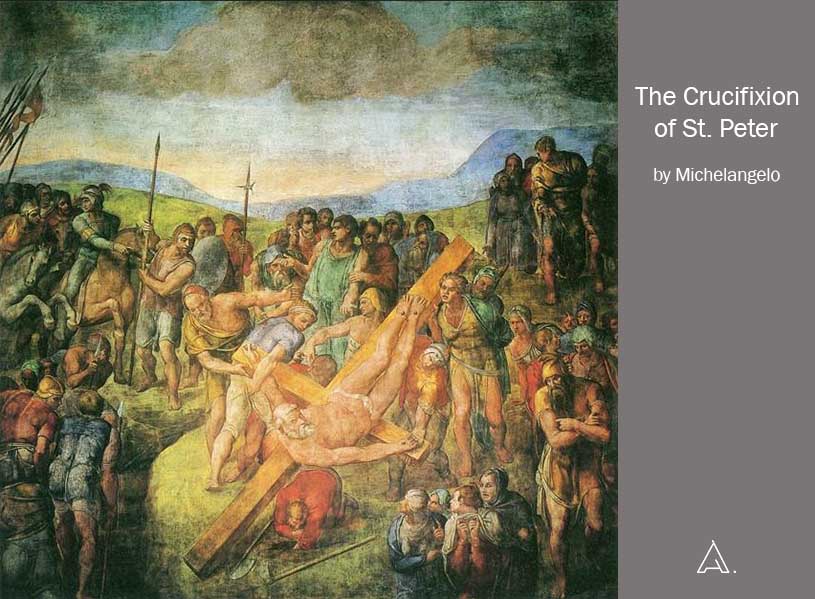
Image via https://getcustomart.com
This prominent fresco designed by Michelangelo can be seen in places such as the Vatican Palace, Vatican City, Rome, and the Cappella Paolina. As a prominent figure in the New Testament and one of the founding fathers of the Catholic Church, St. Peter was portrayed in religious art due to his role in the spread of Christianity. Sadly, the Cappella Paolina is no longer open to the public, and members of the general public cannot view the painting live.
4. The Entombment (c. 1500)
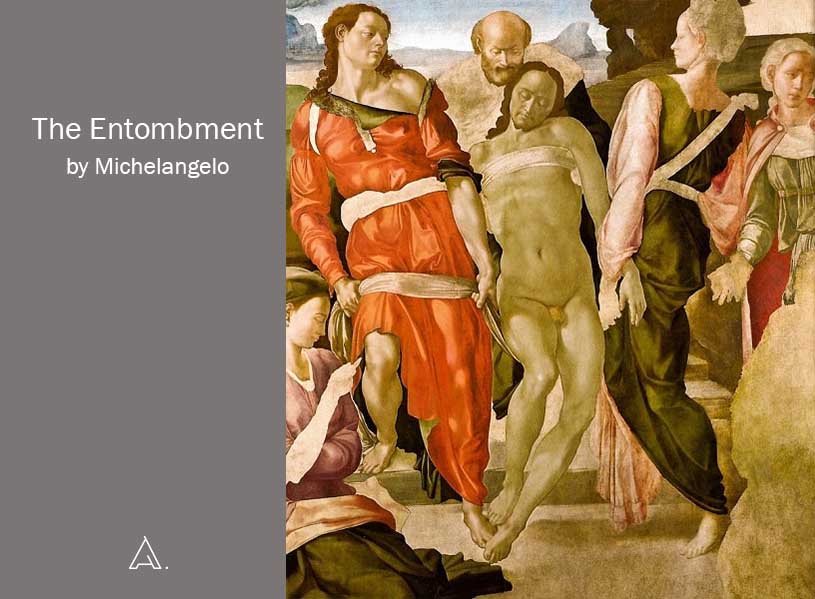
Image via https://www.flickr.com
Till date, this painting has not been completed. There is a controversy on the real painter of the design as some argued that it is Michelangelo that did it while others perceived it was a simulation by one of his students. This painting can be viewed at the National Gallery in London, as the painting was bought from a Scottish photographer who was living in Rome in 1868.
5. Doni Tondo (The Holy Family) (1506 or 1507)
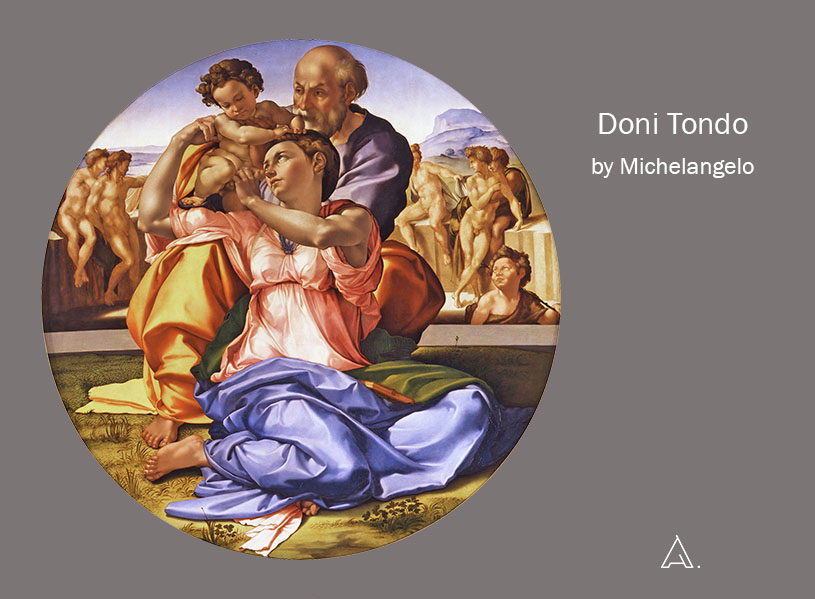
Image via https://en.wikipedia.org/
It is the sole advanced painting done by Michelangelo that has been relevant in our time as it has also preserved its original frame to date. The painting is also referred to as the Doni Madonna; the Tondo means the painting’s circular shape. It was designed to portray scenes related to the home and family and well-known in the Renaissance. The Doni Tondo depicts the Christian Holy Family with the images of Jesus Christ, Mary, and Saint Joseph in the foreground. There are images of some elusively nude male persons in the background. Though no precise explanations were done for them, it has given room for several readings among various art reviewers.
6. The Battle of Cascina
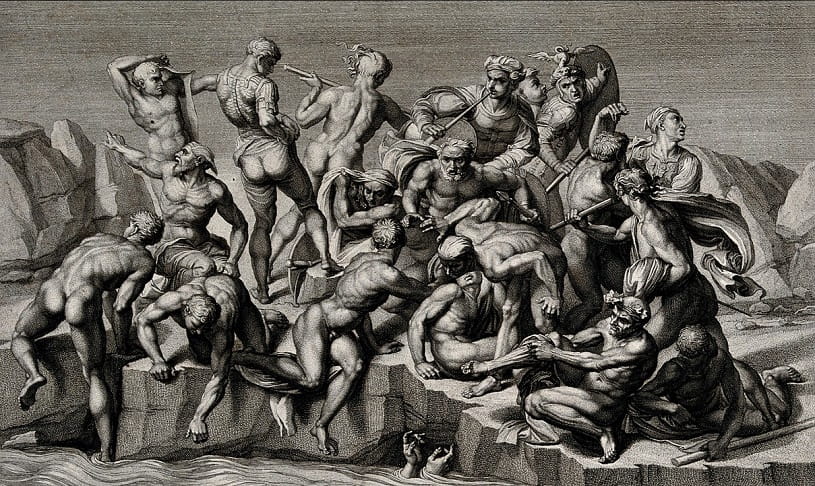
Image via https://commons.wikimedia.org
Another exceptional but unfinished work is the Battle of Cascina. The painting was assigned from Michelangelo by a statesman of the Florence Republic, Piero Soderini. A wall of the Salone Dei Cinquecento room in Palazzo Vecchio was the original painting site.
7. Leda and the Swan
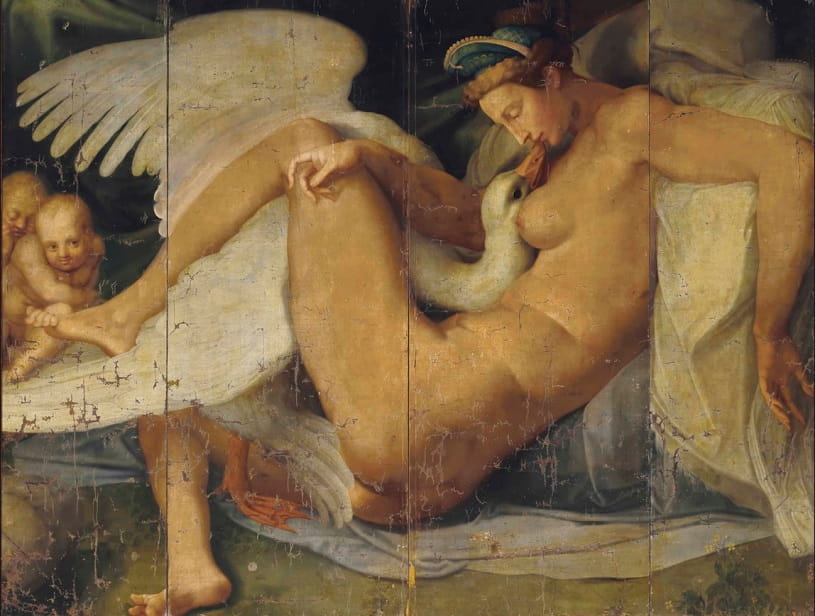
Image via https://www.christies.com
In the Renaissance and Baroque, abducted women seduced by divinities used to be a famous theme. Nevertheless, the first painting by Michelangelo is no longer in existence, but Peter Paul Rubens created a replica of it in 1601 as he had seen the first artwork done by Michelangelo in Rome. Peter maintained the same style by concentrating on the representation of human musculature and proportions.
8. The Conversion of Saul (c. 1542–1545)
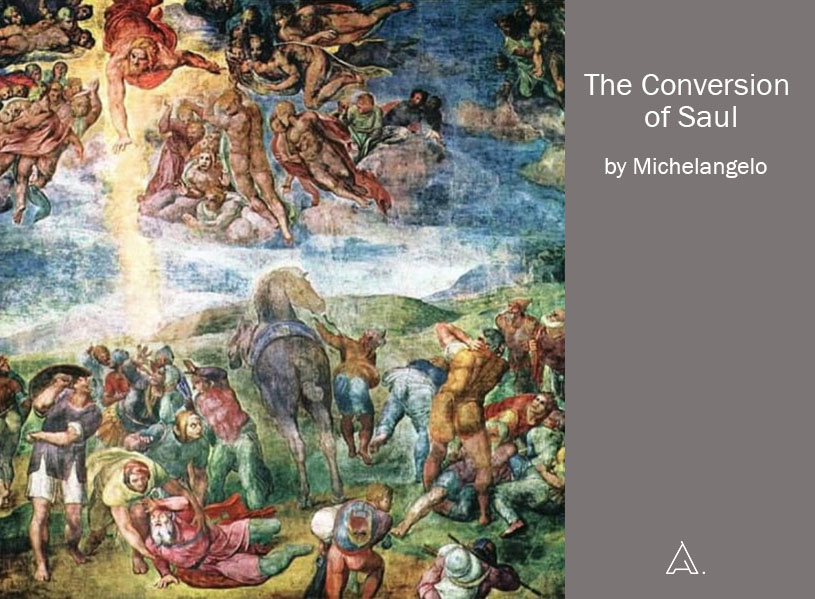
Image via https://www.artbible.info
Michelangelo Buonarotti made this gorgeous fresco in a Biblical theme which can be found in the Cappella Paolina of the Vatican Palace. Most Christians are aware of the story of Saul’s conversion. Saul was a Jewish religious politician and a Pharisee who met Christ and had his name changed to Paul and also became an apostle who preached the good news.
9. The Torment of Saint Anthony
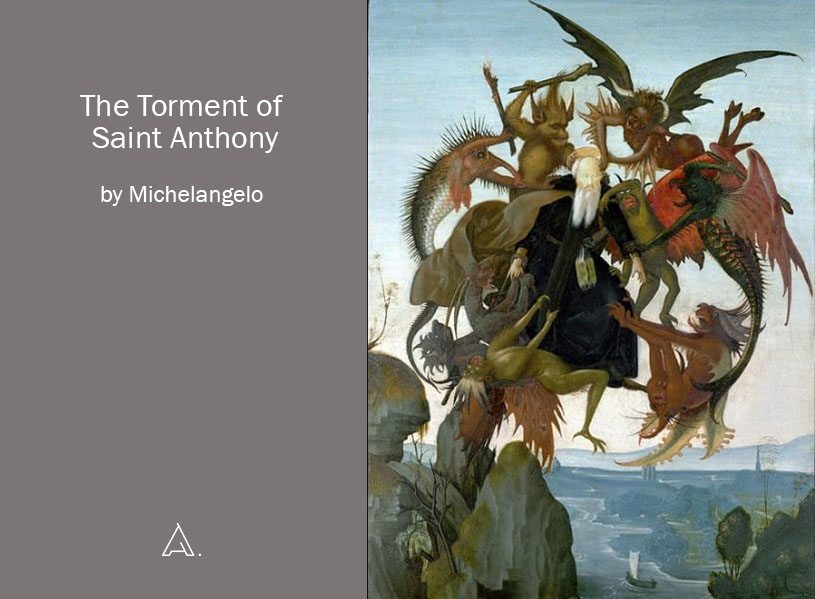
Image via https://www.wikiart.org
It is one of the first paintings created by Michelangelo. Michelangelo was between the ages of twelve or thirteen years when he did The Torment of Saint Anthony. The art agreed with a religious theme of the Temptation of Saint Anthony. It shares the story of a saint faced with several spiritual temptations when he was alive.
10. Madonna and Child with St John and Angels (c. 1497)
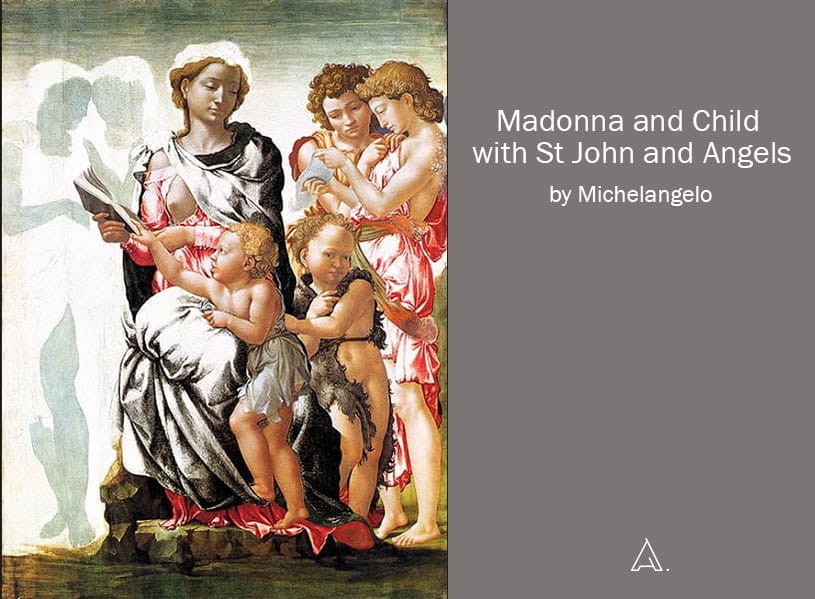
Image via https://en.wikipedia.org
It is also referred to as the Manchester Madonna; it can be viewed at the National Gallery in London.
How did Michelangelo Impact the Renaissance?
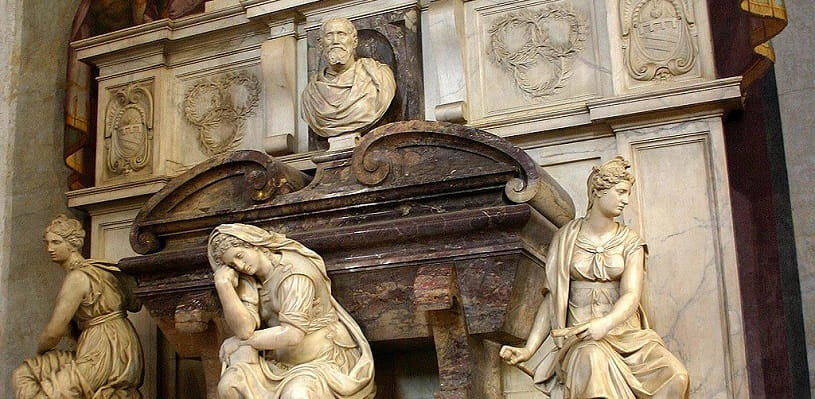
Michelangelo's tomb in the Basilica of Santa Croce, Florence Image via https://www.walksinsideflorence.it/
Michelangelo had an unparalleled influence on the Renaissance. A master of both painting and sculpting, he was also an architect, engineer and poet. His abilities as a painter and sculptor were unsurpassed in his day. While many artists studied under him and assisted him with the painting of the Sistine Chapel in the Vatican, none equalled him as an artist.
Although Michelangelo was a staunch Catholic, he rejuvenated ancient Greek and Roman aspects of art and in doing so, motivated other artists to paint more secular art instead of traditional Christian scenes. This impacted on the humanist movement during the renaissance. What Michelangelo did differently to his predecessors and peers was that he made a hero out of man instead of god.
His techniques of painting were far more advanced than medieval Christian art during the dark ages. By painting the Sistine chapel, Michelangelo revolutionised European art.
Michelangelo may have been working for the pope but he still influenced humanism during the renaissance due to his incorporation of ancient Greek and roman themes as well as scientific elements.
Conclusively, Michelangelo exerted a huge amount of impact upon artists of his time and well into modern times, as well as supporting the humanist movement of the renaissance through his sculpture and art. The renaissance period would have failed to be as revolutionary as it was in Italy and the rest of Europe if he was not a part of the movement. His contributions on the renaissance influenced art and society for centuries afterwards, well into modern western society today.


